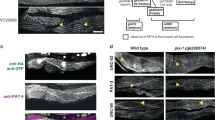Abstract
Muscle development is characterized by several cell-recognition events such as the fusion of primary and secondary myoblasts and synaptogenesis. Cell surface adhesion receptors are probably playing an important role in determining the correct evolution of these processes. In this paper we examine the expression of three cell adhesion molecules, N-CAM, N-cadherin and EP-cadherin, duringXenopus larval muscle development. Their differential distribution suggests a specific role for each of these molecules during myogenesis. N-CAM might control the fusion of primary myoblasts as its expression is particularly high in these cells and decreases sharply in myotubes. EP-cadherin is present both in differentiated myotubes and myoblasts and could be involved in secondary myoblast fusion. While N-cadherin appears only much later during muscle differentiation.
Similar content being viewed by others
References
Dickson, G., Peck, D., Moore, S.E., Barton, C.H. and Walsh, F.S. (1990). ‘Enhanced myogenesis in NCAM-transfected myoblasts’, Nature 344, 348–351.
Knudsen, K.A., McElwee, S.A. and Myers, L. (1990a). ‘A role for the neural cell adhesion molecule, N-CAM, in myoblast interaction during myogenesis’, Dev. Biol. 138, 159–168.
Knudsen, K.A., Myers, L. and McElwee, S.A. (1990b). ‘A role for the Ca+2-dependent cell adhesion molecule, N-cadherin, in myoblast interaction during myogenesis’, Exp. Cell Res. 188, 175–184.
Levi, G., Broders, F., Dunon, D., Edelman, G.M. and Thiery, J.P. (1990). ‘Thyroxine-dependent modulations of the expression of the neural cell adhesion molecule N-CAM during Xenopus laevis metamorphosis’, Development 109, 681–692.
Levi, G., Ginsberg, D., Girault, J.-M., Sabanay, I., Thiery, J.P. and Geiger, B. (1991). ‘EP-cadherin in muscles and epithelia of Xenopus laevis embryos’, Development 113, 1335–1344.
Rosen, G.D., Sanes, J.R., LaChance, R., Cunningham, J.M., Roman, J. and Dean, D.C. (1992). ‘Roles for the integrin VLA-4 and its counter receptor VCAM-1 in myogenesis’, Cell 69, 1107–1119.
Simonneau, L., Broders, F. and Thiery, J.P. (1992). ‘Localization of N-cadherin transcripts in Xenopus laevis from early tailbud to tadpole”, Developmental Dynamics 193, (in press).
Wheelock, M.J. and Knudsen, K.K. (1991). ‘N-cadherin-associated proteins in chicken muscle’. Differentiation 46, 35–42.
Wilkinson, D.G., Bailes, J.A., Champion, J.E. and McMahon A.P. (1987). ‘A molecular analysis of mouse development from 8 to 10 days post coitum detects changes in embryonic globin expression’, Development 99, 493–500.
Author information
Authors and Affiliations
Rights and permissions
About this article
Cite this article
Levi, G. Cell adhesion molecules duringXenopus myogenesis. Cytotechnology 11 (Suppl 1), S91–S93 (1993). https://doi.org/10.1007/BF00746065
Issue Date:
DOI: https://doi.org/10.1007/BF00746065




